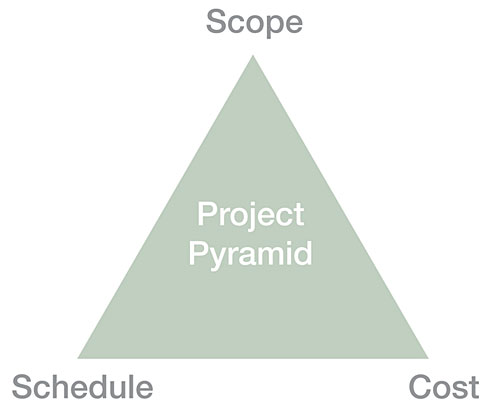Managing Client Expectations to Reduce Professional Liability Risk
The Project Pyramid
The project pyramid (see figure below) represents the three main constraints in any project: cost, schedule, and scope. All the parties involved in the project are concerned with these elements to some degree; conflict is created when you find, usually at some point during construction when it's too late, that the client is obsessed with cost, the contractor's focused on schedule, and you've been concentrating on scope since day one.
|
One of the best ways to manage your client's expectations is to first determine which of these three project components is your client's highest priority. At the very least, the client must tell you which two of the three are his/her main priorities. Emphasizing any of these three undoubtedly affects the others. For instance, if the client states that his/her most important priority is cost, then the scope of the project's design may have to be scaled back to reflect that. If, on the other hand, the client values schedule and speed above everything else, then the scope won't necessarily have to change, as long as the client realizes the project may cost more.
Once you know which aspect of the project is most important to your client, you'll be able to tailor your work to fulfill the client's expectations. But that doesn't mean you'll concentrate on schedule, for instance, and have your interns handle the cost and scope. It does mean that you'll have a better way to decide how to allocate resources and to measure how well the project is living up to the client's expectations.
|
The discussions surrounding the relative importance of these project constraints must be done early in the process and certainly before prices are given and contracts signed. While every client would love to say that "all three" are most important, you need to insist that the client choose one (or maybe two if absolutely necessary). One firm makes it a practice to have the client assign weights to each aspect, with the stipulation that the three cannot all weigh the same.
Your success depends on your client's satisfaction. Your client will be (at least partly) satisfied when his or her highest priority has been well managed. Help your client figure out just which one that is, document the decision, and you're on your way.
Client Evaluation and Education
Now that you know where the client stands in terms of project priorities you have to evaluate just how experienced the client is with the project design and construction process. The best way to do that is to ask. "This will offer some insight into the client's level of understanding and the client's expectations of the designer," says Albert J. Rabasca, Director of Industry Relations for the Design Professional group of the XL Insurance companies. "How the client negotiates and what the client writes into the contract will also tell you a lot about the client's experience. A client who insists on low fees, limited scope, and inappropriately allocated indemnities is a sure sign of a problem client," Rabasca says. "Ideally, you'll evaluate your client before you commit to the project. We've seen too many claims that could have been avoided had the A/E walked away from the project as soon as a red flag was spotted."
It's up to you as the design professional and, in some cases, as the most experienced party on the project, to educate your client about the process at a level that complements the client's experience. Obviously, some will need more education, others less. But in all cases, Rabasca notes, "You can never go wrong taking the time to educate the client about everyone's roles and responsibilities in the design and construction process, including the client's."
Randy Lewis agrees. "The truth is, the success of every construction project depends as much on the client as it does on the designers and contractors," he says. "As early as possible in the planning process, talk to the client about the importance of his/her own obligations. If both sides clearly understand their roles and responsibilities, this sets realistic expectations and helps mitigate the potential for conflict."
Included in your client education process should be a presentation of the services your firm offers. AIA's Practice Management Digest suggests that A/Es can use such a review to confirm that the client understands crucial contract elements such as cost, schedule, etc. Your work in making a detailed presentation will be rewarded in the long run by the increased probability of a successful project and fewer claims.











